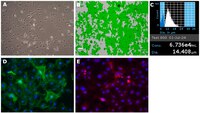SCC226 Sigma-AldrichYUMM1.4 Mouse Melanoma Cell Line
The YUMM1.4 cell line is driven by Braf activation, Pten inactivation, and Cdkn2a inactivation. The cell line is positive for the common melanoma marker, MelanA. The cells are syngeneic with C57BL/6J mice and are very tumorigenic in vivo.
More>> The YUMM1.4 cell line is driven by Braf activation, Pten inactivation, and Cdkn2a inactivation. The cell line is positive for the common melanoma marker, MelanA. The cells are syngeneic with C57BL/6J mice and are very tumorigenic in vivo. Less<<Recommended Products
Overview
| Replacement Information |
|---|
| References |
|---|
| Product Information | |
|---|---|
| Components |
|
| Quality Level | MQ100 |
| Biological Information | |
|---|---|
| Host | Mouse |
| Cell Line Type |
|
| Physicochemical Information |
|---|
| Dimensions |
|---|
| Materials Information |
|---|
| Toxicological Information |
|---|
| Safety Information according to GHS |
|---|
| Safety Information |
|---|
| Product Usage Statements | |
|---|---|
| Quality Assurance | • Each vial contains ≥ 1X10⁶ viable cells. • YUMM1.4 cells are tested negative for infectious diseases by a Mouse Essential CLEAR panel by Charles River Animal Diagnostic Services. • Cells are verified to be of mouse origin and negative for inter-species contamination from rat, chinese hamster, Golden Syrian hamster, human and non-human primate (NHP) as assessed by a Contamination CLEAR panel by Charles River Animal Diagnostic Services. • Cells are negative for mycoplasma contamination. |
| Usage Statement |
|
| Packaging Information | |
|---|---|
| Material Size | >1x10^6 viable cells/vial |
| Transport Information |
|---|
| Supplemental Information |
|---|
| Specifications |
|---|
| Global Trade Item Number | |
|---|---|
| Catalog Number | GTIN |
| SCC226 | 04065272100830 |







